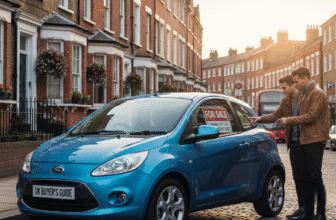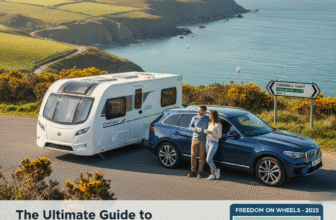
The Ultimate Guide to Finding Your Perfect Ford Fiesta for Sale in the UK
For nearly half a century, the Ford Fiesta wasn’t just a car; it was a quintessential part of British life. From learner drivers nervously mastering the clutch to commuters zipping through city streets and families heading out on weekend adventures, the Fiesta has been a constant, reliable companion on our roads. Its name became synonymous with “first car,” “fun car,” and “sensible choice” all at once. So, when Ford announced in 2022 that the production line for this national treasure would halt in the summer of 2023, it truly marked the end of an era. But while you can no longer buy a brand-new Fiesta, its legacy lives on, stronger than ever, in the UK’s thriving used car market. This guide is for anyone looking for a Ford Fiesta for sale, an enduring icon that still represents one of the best-value, most enjoyable driving experiences you can find.
The end of production hasn’t diminished the Fiesta’s appeal. In fact, it has solidified its status as a modern classic. With millions sold over its lifespan, the market is brimming with options to suit every budget, taste, and need. From the economical 1.0-litre EcoBoost to the fire-breathing ST hot hatch, there’s a Fiesta out there with your name on it. This comprehensive guide will walk you through everything you need to know to find, inspect, and purchase the perfect used Ford Fiesta, ensuring this little legend can become a part of your story, too.
A British Love Affair: Why We Can’t Get Enough of the Fiesta
To understand why the Fiesta remains such a sought-after used car, you have to look back at its incredible journey. Launched in 1976 amidst a global fuel crisis, the original Mk1 Fiesta was Ford’s answer to a demand for smaller, more efficient vehicles. It was an instant hit. It was practical, cheap to run, and, crucially, it was surprisingly fun to drive. Ford had stumbled upon a winning formula that they would refine and perfect over seven subsequent generations.

Each new generation built upon the last. The Mk2 in the 80s introduced a diesel option and the sporty XR2, a boy racer icon. The 90s brought us the curvier Mk3 and Mk4, which focused on improved safety and comfort. But it was arguably the Mk6 (2002-2008) and, most notably, the Mk7 (2008-2017) that cemented the Fiesta’s modern dominance. The Mk7, with its sharp, “kinetic” design and a chassis that delivered a perfect blend of comfort and agile handling, became the UK’s best-selling car year after year. It was a car that simply felt right, whether you were popping to the shops or tackling a winding B-road.
The final generation, the Mk8, launched in 2017, took the recipe and added a generous helping of modern technology, refinement, and an even more sophisticated driving experience. Ford’s multi-award-winning 1.0-litre EcoBoost engine, a small but mighty turbocharged three-cylinder, became the heart of the range, offering a fantastic combination of punchy performance and impressive fuel economy. This constant evolution, this refusal to rest on its laurels, is why the Fiesta has remained at the top for so long and why it’s such a brilliant used buy today.
Which Ford Fiesta is Right for You? A Generation and Trim Guide
With such a vast selection available, choosing the right Fiesta can seem daunting. The best place to start is by focusing on the last two generations, the Mk7 and Mk8, as they offer the best combination of modern safety features, reliability, and value for money.
The Phenomenal Mk7 (2008 – 2017)
Often cited as a high point in supermini design, the Mk7 is a fantastic all-rounder. A major facelift in 2013 introduced the now-famous Aston Martin-esque front grille and, more importantly, the 1.0-litre EcoBoost engine. These post-facelift models are a real sweet spot in the used market.
- Engines: Pre-facelift models came with reliable but less inspiring 1.25-litre and 1.4-litre petrols. The post-2013 1.0 EcoBoost is the one to have, available in 100PS, 125PS, and even 140PS outputs. Diesel options (1.5 and 1.6 TDCi) are incredibly frugal but are best suited for those covering high annual mileage.
- Trim Levels:
- Style / Studio: The basic models. Good for a first car on a tight budget, but they are sparse on equipment (often lacking air conditioning).
- Zetec: The sweet spot. This has long been the UK’s favourite trim, adding essentials like alloy wheels, a heated windscreen (a godsend on frosty mornings), and air conditioning.
- Titanium / Titanium X: The premium choice. These add luxury features like climate control, cruise control, larger alloys, and automatic lights and wipers. Titanium X models often include part-leather seats and keyless entry.
- ST-Line: Introduced later in the Mk7’s life, this trim gives you the sporty looks of the full-fat ST (body kit, firmer suspension, sports seats) but with the running costs of the more sensible engines.
- The ST: The legendary hot hatch. With a 1.6-litre turbocharged engine producing over 180PS, it’s a performance bargain, offering incredible handling and a raw, engaging driving experience.
The Sophisticated Mk8 (2017 – 2023)
The final Fiesta took a significant step up in terms of interior quality, technology, and refinement. It feels like a bigger, more grown-up car than its predecessor, with a much-improved infotainment system (Ford’s SYNC 3 with a touchscreen) being a key highlight. It’s more comfortable on the motorway but retains that trademark handling magic.
- Engines: The 1.0-litre EcoBoost is the star of the show again, eventually offered with mild-hybrid (mHEV) technology for even better efficiency. A non-turbo 1.1-litre petrol served as the entry-level option, which is fine for city driving but can feel a bit sluggish elsewhere. The 1.5 TDCi diesel remained for high-mileage drivers.
- Trim Levels:
- Style / Trend: The entry-point, better equipped than the old base models, often including the touchscreen system. Trend replaced Style later on.
- Zetec: Still a hugely popular choice, offering a great balance of price and equipment.
- Titanium / Titanium X: The comfortable, tech-laden cruisers of the range. Perfect for those who want big-car features in a small package.
- ST-Line / ST-Line X: Immensely popular, offering that desirable sporty aesthetic combined with efficient engines. The ride is firmer than a standard Fiesta, so make sure you test drive one.
- Vignale: The ultimate luxury Fiesta, with quilted leather seats, unique styling touches, and a huge standard specification. A rare but plush choice.
- Active / Active X: A crossover-inspired version with a raised ride height and rugged body cladding. Ideal if you live down a bumpy lane or just like the SUV look.
- The ST: The new king of hot hatches. The Mk8 ST uses a clever 1.5-litre three-cylinder turbo engine producing 200PS. It’s a technical masterpiece, praised by critics for being even more fun and capable than its predecessor.
Your Buying Checklist: How to Find a Great Used Fiesta
You’ve decided on the generation and a rough idea of the trim you want. Now comes the exciting part: finding the car. Whether you’re buying from a Ford main dealer, an independent garage, or a private seller, a thorough check is essential.
Where to Look
- Approved Used Ford Dealers: This is the safest, but often most expensive, option. You’ll get a car that has been thoroughly inspected, comes with a comprehensive warranty, and often includes breakdown cover. This offers fantastic peace of mind.
- Independent Dealers & Car Supermarkets: These offer a wider variety of cars and often more competitive prices. Check their reviews online. A good independent will provide a warranty and an HPI check.
- Private Sellers: This is where you can find the biggest bargains, but it carries the most risk as there is no warranty or comeback if things go wrong. Only consider this route if you are confident in your ability to inspect a car thoroughly or can take a knowledgeable friend with you.
The Essential Inspection
Once you’ve found a promising-looking Fiesta for sale, it’s time to play detective. Don’t be rushed; take your time to check everything.
- Paperwork is Paramount: Check the V5C logbook to ensure the seller’s name and address match the document, and that the VIN (Vehicle Identification Number) on the car matches the V5C. Insist on seeing the full-service history. A car with a complete, stamped service book (or digital record) from main dealers or respected specialists is worth its weight in gold.
- HPI Check: Never buy a car without one. An HPI check will tell you if the car has outstanding finance, has been stolen, or has been written off by an insurance company. It’s a small investment for huge peace of mind.
- Exterior Bodywork: Look for mismatched paint, uneven panel gaps, or signs of overspray on window seals. These can be tell-tale signs of accident damage. Check for rust, especially around the wheel arches and sills on older Mk7 models. Look at the alloy wheels for heavy kerbing, which might suggest hard use.
- Interior Inspection: Does the wear and tear match the mileage? A car with 30,000 miles shouldn’t have a shiny steering wheel or a heavily worn driver’s seat bolster. Test every single button, switch, and function. Does the air-con blow cold? Does the infotainment screen work correctly? Check for any damp smells or damp carpets which could indicate a water leak.
- Engine and Under the Bonnet: Check the oil level and coolant level. Look for any signs of oil or coolant leaks around the engine bay. On EcoBoost models, listen carefully when the engine is running. A whining noise could indicate a potential issue with the timing belt, which is a known weak point if the wrong type of oil has been used. The 1.0 EcoBoost has a ‘wet belt’ (a timing belt that runs in oil), and it’s crucial that the correct, specific Ford oil has been used at every service to prevent belt degradation.
- The Test Drive: This is non-negotiable. Drive the car on a mixture of roads – slow town traffic, a faster A-road, and if possible, a dual carriageway.
- Does the clutch feel right? It should be smooth and not bite too high.
- Do the gears select easily without crunching?
- Listen for any knocking or clonking sounds from the suspension when going over bumps.
- Does the car pull to one side when you brake or accelerate?
- On ST-Line or ST models, be prepared for a firm ride. Make sure you can live with it.
Common Fiesta Foibles
No car is perfect, but the Fiesta is generally a very reliable vehicle. However, there are a few known issues to be aware of:
- 1.0 EcoBoost Wet Belt: As mentioned, using the wrong oil can cause the wet timing belt to break down, leading to catastrophic engine failure. A full-service history with evidence of the correct oil is absolutely vital.
- Powershift Automatic Gearbox: The dual-clutch ‘Powershift’ automatic fitted to some Mk7s has a reputation for being troublesome and very expensive to fix. Unless you have proof of regular gearbox servicing, it’s generally best to stick with the excellent manual gearbox.
- Heater Matrix Failure (Mk7): Some pre-facelift Mk7s suffered from a leaking heater matrix, which can cause a loss of coolant and a damp smell inside the car. Check the passenger footwell for any signs of dampness.
Conclusion: Your Fiest-Adventure Awaits
The Ford Fiesta may have driven off into the sunset as a new car, but its story on Britain’s roads is far from over. It remains one of the most complete, enjoyable, and sensible used cars you can buy. It’s a car that can put a smile on your face on a Sunday morning drive, yet won’t complain about the school run or the weekly shop. It’s a testament to a design philosophy that always put the driver first.
By doing your homework, choosing the right model for your needs, and carrying out thorough checks, you can find a fantastic example that will provide years of happy motoring. The huge number of Fiestas for sale across the UK means you can afford to be picky. Take your time, don’t be afraid to walk away from a car that doesn’t feel right, and you’ll be rewarded with a brilliant supermini that proves why it was, and arguably still is, Britain’s favourite car.







